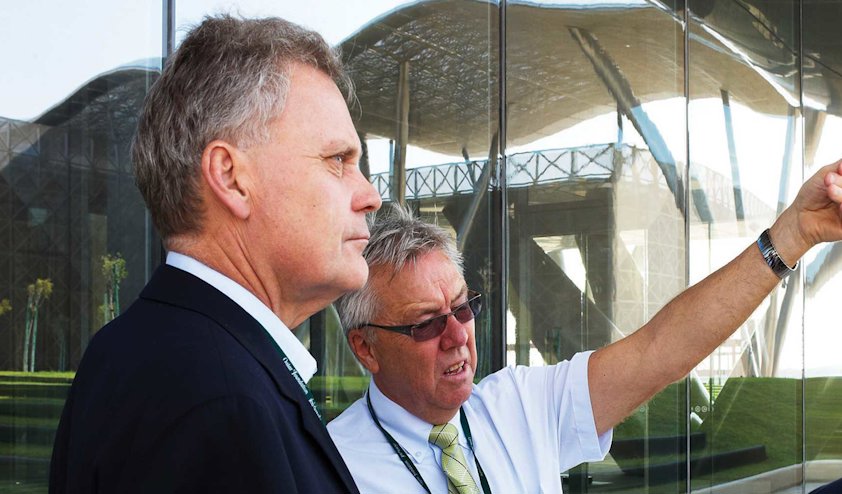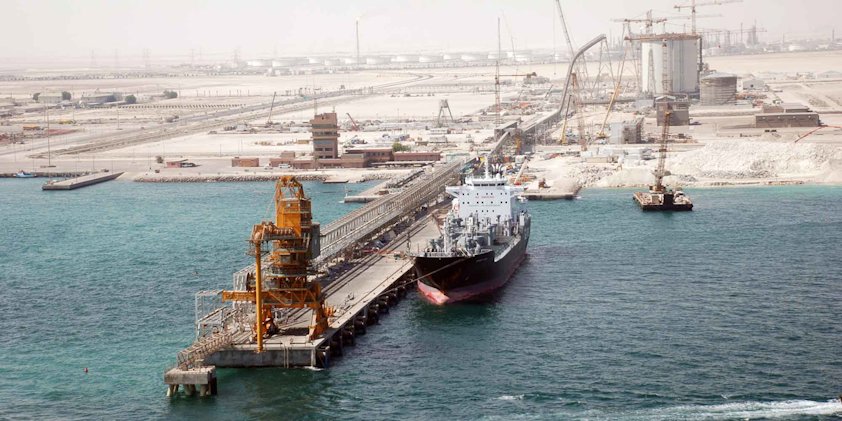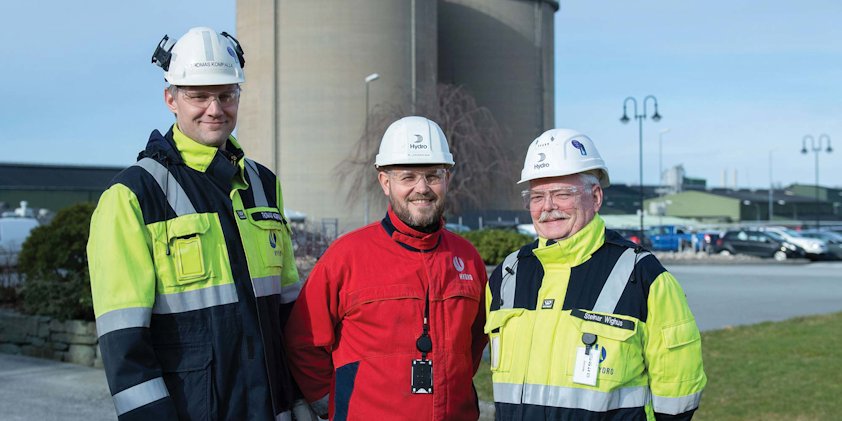Steinar Wighus has one final mission: Get the Husnes re-start up and running
Nearing the end of a long and illustrious career, Chief engineer Steinar Wighus has played a role in some of the most ground-breaking industrial projects in Hydro’s modern history. Here is his and, in many ways, Hydro’s story.
After a long period of uncertainty related to Covid-19 and the market situation, Hydro decided to restart production at Line B at the Husnes primary aluminium plant in Norway by the end of November, after running the plant for more than a decade at half capacity.
Executive Vice President of Hydro's Primary Metal business area, Eivind Kallevik, is happy that the restart has begun – and that it has positive ripple effects in the local community.
“This is a milestone. The restart of the B line at Hydro Husnes is not only of great importance to Hydro, but also to the local community surrounding our plant. We have invested NOK 1.5 billion in upgrades and the production line holds world-class standards in climate, environmental and operational performance. In addition to doubling the production of aluminum based on renewable energy, the restart of the B line contributes to almost a hundred new jobs," said Kallevik in the press release from November 25, 2020.

The project itself to re-start the B hall is enormous, even compared to other big Hydro projects in recent decades. The two biggest comparable ones are Qatalum in Qatar and more lately, the Karmøy technology pilot project in Norway.
Engineer by heart – and without borders
Zoom into ground level, inside the great and historical B hall at Husnes, we meet one of the Hydro employees who has been a vital part in all of the mentioned projects.

“You know my plan is still to retire this year, but I won’t go until we get these 200 cells up and running and start production again. So…I guess we’ll see what happens,” Steinar says with a twinkle in his eye.
But before we get to Husnes and the B hall restart, we have to turn the clock back a few years, and dive into Hydro and Steinar’s history.
Steinar is originally from Skien, educated at “Skien tekniske fagskole” and with several degrees and subjects he could eventually call himself an engineer. Growing up, he spent all his summer holidays working at the local paper factory called Skottfoss Bruk.

A shipbuilder in South Korea 26 years old
He moved to Oslo for his first engineering job, with a consultancy company that made ships where he designed machines.
This was the start of a long journey with jobs overseas.
One of the first ships Steinar worked on, where he designed the machine room, turned out to be the famous refugee ship called “Lysekil”, which picked up 252 Vietnamese boat refugees in the South-China sea in 1979.
After a few years in Oslo, Florø and Førde in Norway, a job opportunity in South Korea at Veritas, now known as DNV GL, emerged. Steinar did not hesitate to go, 26 years old.
“I was there for 13 months and was managing 200 Koreans, ranging from secretaries, electricians, engineers, designers – everything,” he recalls.
And with how the world shifted and progressed, it was only fitting that Steinar’s next adventure would be in oil and gas.
When oil needed floaters – shipmen were wanted
Up until that point in the 1980s, Steinar and other shipbuilders were not in demand in the oil and gas industry.
But when gigantic floaters started to become an option, ship engineers were highly valued. He was hired as a contractor from Aker Engineering – to Hydro.

“I was responsible for the emergency power modules for the Oseberg A platform. I travelled to Kristiansand in southern Norway where the modules were to be built and got on the isometric drawings – which is 3D drawings before they turn into models. Hydro needed it to be in a very specific way. Challenging, but also great, great fun to work with.”

After the designs were done at Oseberg A, he moved to Egersund and became part of the site team there, responsible for piping in the generating modules. He worked offshore for two years, working shifts with two weeks on and four weeks off.
The ’90s – the glory days of Hydro Projects
After being a contractor in Hydro for six years, the then-conglomerate wanted to hire Steinar permanently. Times were good for Hydro and its many projects around the world.
“It was a different time back then. The Projects department in 1991 had 500 employees from all possible areas needed to build a platform. Safety, architects, noise reduction, electricians – you name it. Everyone expert in their respective fields, whereas today I think the younger generations need to be more multidisciplinary,” he says.
Steinar started out as team lead for 15-20 people, and says people were taken care of and how their development was carefully nurtured was top drawer.
“People were treated with utmost respect and put in positions, mostly technical, that they not only excelled in but developed and learned something new every day,” he recalls.
In 2007, Statoil bought Hydro oil and gas and 90% of the people in Project followed.
“This was not a good moment I must admit. I considered myself to be an offshore guy, but they all wanted me to throw in the anchor and become a land-based engineer? I fought a long time against this, I felt betrayed and I felt that the men and women I worked with and I was in charge of, were betrayed,” he says.
But another prominent figure in Hydro’s modern history, Tom Røtjer and a gigantic, looming project in the Mesaieed Industrial City outside Doha, Qatar, turned out to be the decisive factor for Steinar.
Qatalum – world-class aluminium plant with the best of the best
“Tom Røtjer called and basically said ‘We want you here and I want you to be the technical responsible for this project,’” Steinar says.


If you did not know, the Qatalum development is the largest Norwegian industrial project abroad.
Hydro’s project organization managed the project, with a total investment of $5.7 billion. First metal was produced – on schedule – in December 2009 and the plant reached full capacity in the fourth quarter of 2010 – again according to plan.
This was the result of more than 90 million working hours.
More than 56,000 workers from more than 200 companies have been directly involved in the construction in Qatar.

And the person in charge of the technical development and follow up for all areas, at the time more than 22000 personnel on site? You guessed it – Steinar Wighus.
Before they started the job in the deserts outside Doha, the groundwork had to be laid out.
“We worked for two years in Oslo before we went over. We did the underlay, technical specifications and made all the different contracts, and of course heavy internal recruitment,” he recalls.


When asked about the assembled crew to do the job, Steinar stares hard and intently while saying without hesitation: “The Qatalum crew in Hydro were the best of the best.”
In Qatalum, Steinar got to know a colleague who today is his boss – Kristin Mørkved, Head of Projects in Hydro.
“Kristin started in Hydro at that time. She was responsible for the installation of the 704 cells ran on HAL275/300 technology, which at that time was the ultimate and latest cell technology. Of course, that was developed in Hydro,” Steinar smiles.

Nobody had ever done what Hydro did
When arriving in Qatar, Steinar was left speechless.



"The area where we were going to build the plant was enormous. You could play all the football games in the World Cup on the site – at the same time,” he says.
To fill up the area with limestone mixed with dune sand, in order to have a foundation to build the plant on, the team had to drive trucks every minute and a half for nine months.
And the port area was built for coke, pitch and alumina silos.
Steinar shakes his head.
“The things we did there and had to build. We built the entire aluminium plant with all necessary support systems. We even built a power plant – and a mosque!”




Five years and 90 million working hours
After almost five years in total, what once was a dream in the desert became a reality, thanks to major parts of Hydro’s organization.
And after two years, many of Steinar’s colleagues that he had worked alongside with day and night, were heading back home.
Steinar, on the other hand, stayed on for two more years commuting between Oslo and Qatar.
“I must admit that it took a toll on me. It was quite boring without my family for a longer period. You end up drowning yourself in work,” he says.
What do you do when 444 cells freeze?
It was during that period Steinar experienced his first big crisis at work, and the potential damage that could occur at an aluminum plant when cells freeze.
“Without being too bombastic, you only have 2-3 hours when a power outage happens before electrolysis cells freeze. And if you don’t get the power back – it’s game over.
“When this happens, you are searching for the root cause in order to fix it and get the power back. Is it the main wire into the plant or is it an internal error at the plant? Is a transformer burned, can we use installed spares. One thing is for certain – everybody is on 110% capacity and everybody knows what they have to do because we have trained for this.”
Kirstin was part of the restart task force, which could be described in a Monopoly game; “return to start” and a rebuild of more than 400 cells happened over the next six months.
Back to Oslo – but not for long
“Back in Oslo, I worked a bit with the project manager for the power station. We had to fix a lot of things that were not done according to standard,” he says.
Steinar just managed to set his feet on the table back his home, when Tom Røtjer called. The cooling tower in Qatalum started burning. And it burned to the ground.

Tom asked “Can you go to Qatar?”
“Yes, sure. But it was Saturday, can I wait until Monday?” Steinar said.
“Sure, sure” Tom replied.
“When I arrived, the area was still hot. A real fire had occurred.”
So, what did they do?
“We looked for alternative solutions. Can we cool with the secondary power plant? Set up a temporary cooling center? Many things were considered but all of them too expensive, the same as building a new tower.”
The Italian supplier who built it was interested in coming down, so they did.
But could they help and provide all the necessary parts?
“They made an order for all the parts and signed the contract. We built it up again in record time and had a new gas turbine ready and fully functioning within six months,” Steinar said.
Emergency job in Paragominas – proved decisive in 2019
It did not take long after he got back before Steinar was on the road again.
A call from Corporate HQ came. They needed help in Paragominas; Brazil, to set up an emergency power module, needed to secure insurance for the plant.
“Immediately we sat together a small team of electro engineers, logistics, purchasing and myself. We made up a contract and went to Brazil.”
Work began to set up an emergency power module, but there was no time to build it up in that scale. The power requirement was 15 MW, so it was quite large.
“We brought in used generator modules from the World Cup in soccer and connected it with a control system and ran several tests, where it worked fine. After that, we went home.”

Fast-forward a few years forward, in December 2019 when a power outage affected production at Paraogominas and Alunorte, temporarily halting production at the mine. The 244-km bauxite pipeline from Paragominas to Alunorte was being emptied using back-up power.
The source of the back-up power? The emergency power module created by Steinar and his team in 2014.
Technical manager for the Karmøy technology pilot project in 2017
In 2015, Hydro made a formal investment decision to develop a full-scale pilot plant in Karmøy, to confirm the feasibility producing the most energy- and climate-efficient aluminium in the world. At the time, it was the largest investment Hydro had made in a decade.
When the work started to build the pilot plant at Karmøy Steinar worked as Company representative for the mechanical installation contract. In 2017 he also took on the role as Technical manager.

“It’s funny because Victoria Kielland Einejord actually had the job before me, but since we also had to initiate the Husnes plans at the same time, I took her place and Victoria started as Project manager for the early-phase plans of that project,” Steinar said.
As with the other projects – this too was challenging and a steep learning curve for those involved. A lot of progress was made in going from paper do digital, such as checking each component on paper before installation.

In this project, 6,950 main components, 15,180 cables, 5,781 instruments, 3,031 electrical equipment and 2,147 pipelines were checked through 16 online boards, instead of doing it on paper.
“Previously, we only used checklists on paper, which were then scanned into the database. In total, the online boards helped us ensure that a total of 39,705 equipment components to the pilot were installed correctly. So, for Projects, this was a pilot in the pilot,” Steinar says.
Husnes – skilled people and a mentor
Steinar describes the Husnes B hall restart as one of the most fun projects he has been around. Much thanks to the young people he worked with.
He has taken more of a background role, working and helping out where needed – and of making sure his competence is passed on to the next generation. And it’s working with the youth that has energized his final chapter in Hydro.


“It’s a great work environment here. I have tried to pass on some of my knowledge this time. But make no mistake about it – the younger generations and teams here are really, really skilled. They catch things very quickly,” he says.
“One of the things we’ve done well here is that we have managed to collaborate closely with the production team in Primary Metal throughout the entire project. That has not always been easy. Both sides have a way of working and different culture, but the integration here has been top, top class,” he says.

Key in designing the next steps for Projects
With Hydro a company in constant renewal, the Projects organization also needs to adapt and is positioning it for the future. Steinar has contributed his advice and experience, says Kristin Mørkved, Head of Projects.
“As we don’t have so much of the Qatalum, Karmøy or Husnes projects coming up, our efforts will focus more on the smaller and medium projects by establishing a center of excellence for project management. Here we will offer methodology and tools to the many new and exciting initiatives in Hydro,” says Kristin.
Sets sail one last time
After being more or less on the run or on the go throughout his entire career, for the past 10 years he’s built a second ‘home’ that he can easily move around when he has been in Norway: A boat he bought in 2011, and has built on ever since.

“I spent pretty much every vacation or break I had just building on it, so you can say it’s turned into a hobby,” he chuckles.
And, with his final project finally up and running, it’s safe to say Steinar can take a deep breath and pass his helmet on to the next generation after almost 40 years in Hydro, and set sail for his next adventure looming on the horizon with his wife and family.
Steinar retired from Hydro in December 2020. The next day, he established a sole proprietorship.
